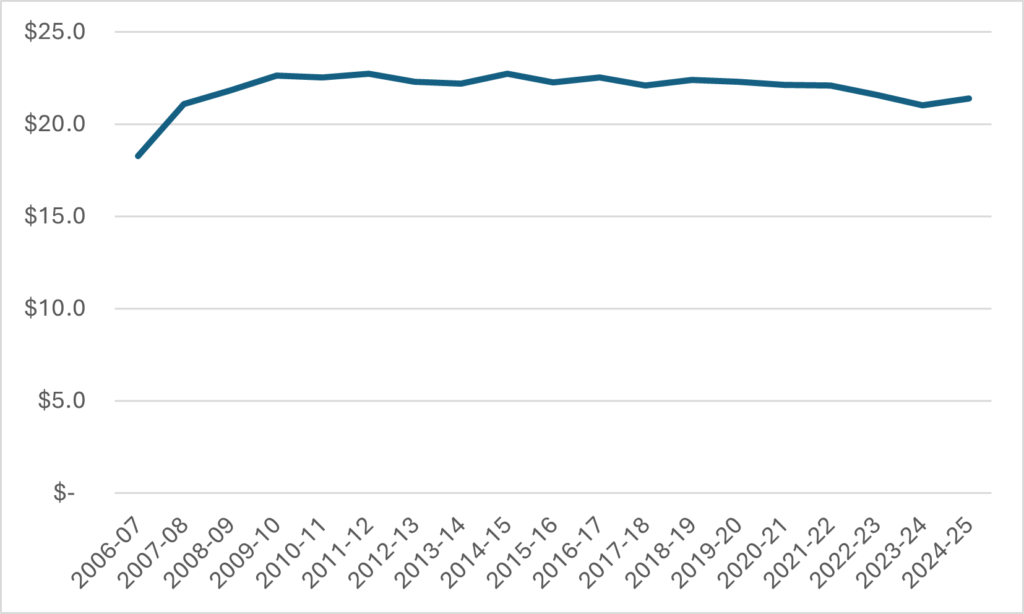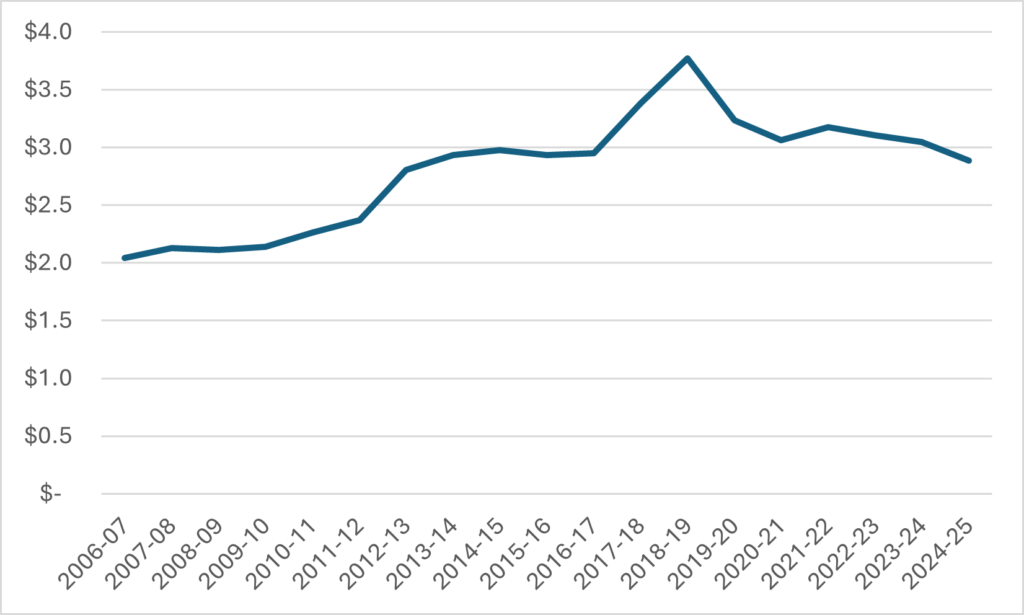Morning, everyone. Yesterday, the government of Manitoba delivered its annual provincial budget, making it the tenth and final one to do so. That means I can do my annual analysis of provincial budgetary commitments!
A couple of caveats before I start. First, there are several provinces that have changed the way they describe their post-secondary budget expenditures in their main estimates. The most important of these is in Quebec, where about a half-billion dollars in capital expenditures has disappeared from the Ministry of Advanced Education’s budget. It’s absolutely not clear to me that this is an actual reduction in expenditures on post-secondary education, or if it’s simply a shifting of budgetary responsibility from the Ministry to the Plan Québécois des Infrastructures. In the absence of data, I will treat it as a reduction, but just keep in mind that the way I am reporting the Quebec data might undershoot “real” expenditures by a significant amount.
Second, the Ontario budget is a bit of a guess, for reasons I explained back here. I’ve done my best to estimate expenditures given the province’s deep commitment to secrecy, but I might be off a bit.
Third, Newfoundland, New Brunswick and Manitoba have all slightly changed their reporting procedures, none of them in a direction that makes reporting much clearer. I have tried as best as possible to keep their data consistent.
With all of that that in mind, Figure 1 shows the 1-year and 5-year changes in real provincial support to post-secondary education based on provincial budgetary allocations. There are two obvious comments which need to be made here. The first is: what in the hell is going on in British Columbia? How are the increases here so massive? And the answer is: i) BC government pays for institutional salary increases, and for a variety of reasons, salary settlements for the past couple of years have been incredibly generous and ii) the one-year increase shown here is actually two years because the increase occurred mid-way through the 2022-23 year and iii) there’s a bunch of start-up funding for a new medical school at Simon Fraser in there too.
The second thing to note here is that—BC apart—the age of big swings in annual government expenditures seems to be more or less over. Newfoundland and Alberta—two oil provinces that have spend much of the last few years reining back on PSE spending—now have annual swings close to zero (though the five-year swings are still pretty big).
Figure 1: One- and Five-Year Changes in Real Budgeted Provincial Transfers to Post-Secondary Institutions, by Province, 2024-25 Budget Cycle

The net result of al this is that while most provincial spending is pretty even, the huge change in BC somewhat outweighs the big (potentially misleading) drop in Quebec to result in a 2% increase after inflation, which is the biggest rise since 2014-15.
And what does it look like if we aggregate all that provincial data and stick it in one long line-graph? As Figure 2 shows, total provincial transfers to post-secondary institutions were pretty flat between 2010 and 2020. That is not to say they were flat in every province but that the ups and downs in various provinces have tended to offset one another. The period 2020-2023 was marked mainly by real declines due to high inflation; this year breaks that pattern, at least temporarily.
Figure 2: Aggregate Budgeted Provincial Transfers to Post-Secondary Institutions, in Billions of $2024, Canada, 2006-07 to 2024-25

Now, over to student financial aid. This one is a bit harder to track because some provinces have weird ways of accounting for—or at least publishing—their data on student aid. The jump in Newfoundland and Labrador, for instance, is likely reflective in how its data is provided (2018-19 was the year the province changed the way it administered funding and marked a big drop from previous years, so this increase is building off an artificially low base). Manitoba I don’t quite know what is going on, but the value of the province’s bursary program seems to be going up quickly and steadily despite no obvious policy change. Other than that though, what we seeing over the past five years is a very slow reduction in national aggregate of provincial student assistance is still down roughly 20% over the past half-decade.
Figure 3: One- and Five-Year Changes in Real Budgeted Provincial Expenditures on Student Financial Aid, by Province. 2024-25 Budget Cycle

And that brings us to Figure 4, which looks at aggregate budgeted student assistance funds over time. This graph looks quite different from Figure 2 because provincial governments on the whole have been much happier to give money to students than to institutions. Despite cutbacks, real provincial student aid budgets are up by a third over where they were in the late 2000s. But they are also down about twenty-four percent from where they were when Ontario still had its targeted-free-tuition program under the Wynne government.
Figure 4: Aggregate Budgeted Provincial Expenditures on Student Financial Assistance, in Billions of $2024, Canada, 2006-07 to 2024-25

And that’s your budget analysis for 2024. Tl;dr: this was a relatively decent year for provincial spending overall, but a lot of it has to do with some very one-off changes in British Columbia. But this is not yet a sign that provinces intend to reverse the long-term stagnation in spending on higher education.

 Tweet this post
Tweet this post

Thank you very much!! Very appreciated.
Would it be possible to get an updated 2024 figure of PSE spending per student by province, like Figure 1 here?
https://higheredstrategy.com/comparing-provincial-expenditures-on-post-secondary-education/